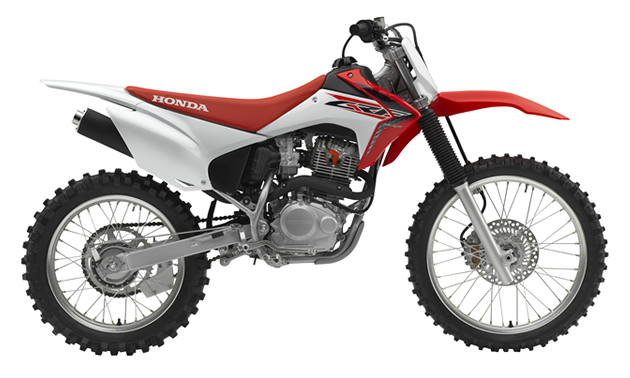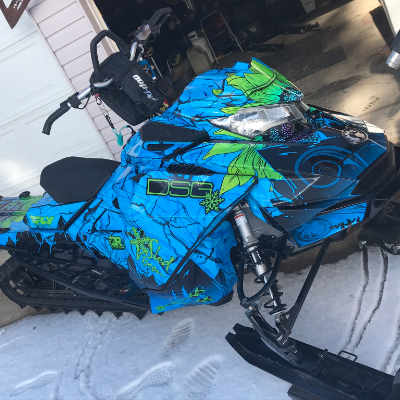An adrenalin junkie of some sort sees a YouTube video of a professional motocross rider masterfully navigating a big, sexy, powerful dirt bike along a twisty, rocky, mountainous trail at a considerable clip. He lofts the wheel over logs, rocks and great gaping gaps, wheelies across shallow rocky rivers, climbs impossibly steep inclines, and then jumps across the Grand Canyon, doing a Double Back Flip 780 Full Gainer against a clear blue sky, before finally landing, skidding and sliding to a stop in front of a beautiful blonde with a power drink in her hand.
The junkie thinks, “I’d like to do that,” and sets about buying a big, sexy, powerful dirt bike.
This scenario will likely go bad.
There are way too many variables to give singular global advice to first-time dirt bike buyers, but there are some common mistakes that can be advised against, and some critical time and money-saving information that can be shared.
For example, “You’re not good enough to live that dream,” or, on a more pragmatic level, “A dirt bike is not just a dirt bike—there are different kinds.”
Play bikes
A play bike is a bike that is designed to be used and abused in the dirt. It’s not designed to break any world records at anything in particular, but rather to not squabble about doing a wide variety of dirty, mundane tasks. One of its biggest perks is low maintenance. The play bike just doesn’tcare, which is optimal for a first-time dirt biker.

Play bikes, such as the 2016 CRF230F from Honda, are meant to do a variety of tasks and they are low maintenance. — Honda Motorcycles photo
Competitive trail bikes
These are bikes specifically designed to deal with tough off-road conditions. They are rock climbers, river riders, mud slingers and tree dodgers. Most are based on a motocross bike, but the engine is detuned and the gearing is lowered and widened.
The purpose of detuning and re-gearing the engine is to make it more manageable to ride in tight situations, but the unintended upshot is that they also tend to require less maintenance than a full-blown motocross bike. Win-win for a new dirt biker.

Gas Gas is a Spanish motorcycle manufacturer that makes a very solid competitive trail bike. — Gas Gas photo
Motocross bike
A motocross bike is a race-ready machine, suited for long periods of high-revolution output and high-speed manoeuvrability. These bikes require more maintenance than other dirt bikes as a rule, but in the right hands there is nothing they can’t do. They have roughly the same power-to-weight ratio as a Formula 1 race car.

Yamaha has been in the motocross game for several years and its YZ450F comes ready to take your racing to the next level. — Yamaha Motor Canada photo
Dual purpose
Dual purpose bikes are designed to be operated on both dirt and pavement. In most cases, a dual purpose bike would rate as a “play bike” in the dirt. There are street-legal versions of some competitive trail bikes, but these are not truly “dual purpose” bikes, they are street-legal dirt bikes.

Suzuki’s DR650 is a street-legal bike that can be run on pavement and dirt. — Suzuki Canada photo
Suitability
In the end, it’s all about suitability, for new dirt bikers and seasoned ones as well. Particular dirt bikes are not better or worse in a general sense, just better suited to a particular task.
Experienced riders are well aware of what they require to suit their needs, but it's much more difficult for new riders because they have no experience to form an opinion from. New riders will try to imagine how they will use a bike, but in my experience, imagination is not as accurate as real experience.
I have several real-life experiences of a newbie's imagination leading the rider wildly astray.
Case #1:
“Mr. X” can do anything bigger and better than anybody—he told me so himself.
He wanted to start riding the beautiful single-track trails in the woods on Vancouver Island with his buddies, who had KTM and Gas Gas two-strokes (competitive trail bikes). He thought it would be nice if he could get a bike that he could ride on the road to the trails so he didn’t have to bother with a trailer, and also if it was “bigger” than his friend’s bikes that would be good, too. He bought a Honda XR650 for these reasons. He had no dirt bike riding experience.
I next met Mr. X when he came back to trade in the freshly damaged 650 after his first ride in the woods, an event he was apparently unable to visit in his conscious mind. When I asked him about it he shuddered and a glassy, distant look washed over his eyes. All he could say was, “I’ve experienced horrors too brutal to recall,” and then he was distracted by an itch under his cast. So we left it at that.
Mr. X made several common mistakes in his assessment of what he wanted, which are easy to avoid with just a little homework.
The XR650 is labelled as an on/off-road bike, and it is well suited to certain types of wide open off-road situations, but the single-track trails on Vancouver Island are not those kinds of situations.
They are tight, twisty, nasty, rocky, hilly excuses for goat trails. An XR650 is far too heavy and cumbersome for them. As an off-road bike, the XR650 (and KLX650) would be considered a “play bike,” and a big, heavy one at that.
If Mr. X had gone to see what the trails his buddies rode on looked like, or taken note of what kinds of bikes they rode (competitive trail bikes), he might have surmised he didn’t have the skills to pilot a 500-pound “sort of” play dirt bike through that kind of terrain; few do.
Takeaways
Visit where you intend to ride. Assess the difficulty level of the terrain, and take note of what others are riding. Be realistic about your abilities. Don’t believe you can do what no one else is doing—you probably can’t.
A “dual purpose” bike is rarely as good at either of its purposes as a bike designed with a sole purpose. The dual-purpose bike will work fine on logging roads and wide open trails (basically unpaved roads), but when the going gets rough—you’ll wish you had a single purpose bike.
Bigger is not always better. There is an inclination, especially among men, to feel that bigger is better. This is definitely not the case with dirt bikes, especially for a novice rider.
Solution
Either purchase a competitive trail bike, of which there are a plethora of options, or start out with a smaller, more manageable play bike. Even the XR650’s little brothers, the XR250 or CRF230, would be suitable.
The benefit of the play bike option is largely one of reliability and maintenance. There is a lot to be said for a forgiving, “kick-it-and-go” type of bike for a novice. Dirt bikes require significant amounts of maintenance and it takes time to learn even the fundamental maintenance routines—best to learn on a bike that will more easily forgive your mistakes.
It also takes time to learn how to ride. A first-time rider will quickly learn that riding a bike through difficult terrain is, well, difficult. You may have visions of slicing and dicing your way through the forest on a KTM 350, but a year in a corn field on an old 250 play bike might be more realistic to begin with.
Case #2
Another classic first-time buyer’s error is what I’ve dubbed the “Miserly Overachiever” syndrome. Please don't fall into this category.
A young buck, about 12 years old, was interested in a dirt bike to ride with his buddies, so he came by with his father. His friends all had motocross bikes so he wanted one. I might normally advise a rider to work his way up to a full-on motocross bike, but kids will be kids, and they usually catch on fast. We had a recently rebuilt, late model KX85 I was suggesting to him. It fit him well, but it was a used race bike, which the young man’s father didn’t like.
The next time I saw the kid, he was bringing in the bike he eventually bought for us to repair. He had found a similar, slightly older 125 motocross bike for less money than the 85 I wanted to sell him, and it had never been raced. Seemed like a “gimme” his dad explained. More bike for less money.
It was a little too big for him, but his father was sure he’d grow into it. The bike just had a couple little problems, but both father and son were confident they could fix ’er up.
Unfortunately, by the time the little problems were fixed, the bike was considerably more expensive than the 85, and on his first time out, the young fellow lost control of the bike and crashed it into a tree. It’s unclear if the crash was due to rider error or a mechanical issue, or a bit of both. Regardless, there was substantially more damage than the bike was worth.
By the time it was repaired again, it had cost more than twice what the 85 was priced at, not to mention the tremendous amount of stress and frustration the whole fiasco caused. And, of course, the irreparable emotional damage to the tree.
Takeaways
Spending less often costs more. If you are buying your first dirt bike you ARE NOT qualified to attest to its mechanical soundness. Have a mechanic check it out! Most shops will do a mechanical inspection for $50 to $100, which is a pittance compared to virtually any repair on any motorcycle. If they find one thing in need of immediate attention the inspection will likely pay for itself.
Don’t be afraid to purchase a bike that has been raced. The fact is that race bikes are generally the best maintained bikes out there. You don’t send a kid out to race on an unsafe bike, and keeping it fresh is necessary from a competitive perspective. By comparison, the more casually a bike is used the more casually it tends to be maintained.
Motorcycles are not like kids’ shoes. It’s not a good idea to buy them one size too big and let them grow into it. If you put an 85-sized kid on a 125 motocross bike, there is a good chance he will be in a cast before he grows into it. Be prepared to buy a new bike every year or two as the child grows. Get good at buying the right bike, keeping in mind you will be selling it sooner than you’d like.
Solution
Buy the right-sized bike, and have it checked over by a mechanic.
A moving target
Suitability is a moving target, especially when a rider first starts out and their learning curve is at its steepest. What suits a rider now may not suit them in a year, let alone forever. As a rider develops in skill and experience their needs will change. This seems to be especially true for young boys who quickly master the fundamentals of the machine and start going faster, hitting things harder, and jumping higher than their first bike is comfortable doing. It’s important, even from a safety standpoint, to make sure you keep the bike up with what the rider is doing, even if it means going through a few bikes in quick succession in the first years.
Your first bike may not be suitable for very long, but you should not confuse “ultimate” suitability for what is “currently” suitable. Shopping for the bike you “imagine” doing things on—eventually—often leads people to buy bikes that are unsuitable as first bikes; they are often too much bike, or require more maintenance than the newbie is capable of.
With young boys as the prime example, it’s tempting to want to buy bikes like shoes (one size too big) and grow into it. This is not generally a good idea with motorcycles.
Buy the bike that suits the reality, not the dream.








Comments